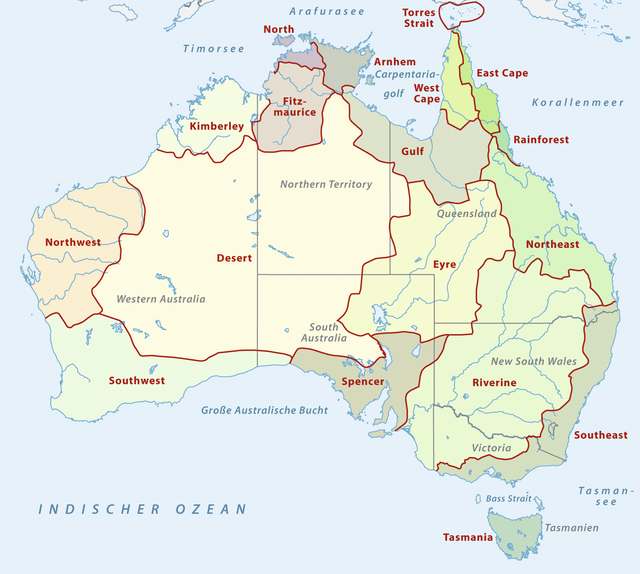Loading AI tools
Aboriginal Australian cultural region in Central Australia From Wikipedia, the free encyclopedia
The Western Desert cultural bloc (also capitalised, abbreviated to WDCB, or just Western Desert) is a cultural region in central Australia covering about 600,000 square kilometres (230,000 sq mi), used to describe a group of linguistically and culturally similar Aboriginal Australian nations.

The term Western Desert cultural bloc is often used by anthropologists and linguists when discussing the 40 or so Aboriginal groups that live there, who speak dialects of one language, often called the Western Desert language.[1] The term cultural bloc is used by anthropologists to describe culturally and linguistically similar groups (or nations) of Aboriginal peoples of Australia.[2][3]
According to anthropologist Robert Tonkinson:[4]
Extending over a million square miles, the Western Desert... covers a vast area of the interior of the continent. It extends across western South Australia into central and central northern Western Australia (south of the Kimberleys) and south-western Northern Territory, and it includes most of the hill country in northern South Australia..The area is marked by an overall similarity in both climatic conditions... and physiographical characteristics. More important, however, is its delineation as a distinct culture area.. its Aboriginal inhabitants share a common language (with dialectal variations), social organization, relationship to the natural environment, religion and mythology and aesthetic expression. The term Western Desert, then refers to both a cultural bloc and a geographical entity.
The WDCB covers around 670,000 km2 (260,000 sq mi) and extends across much of Western Australia, parts of South Australia, and parts of the Northern Territory.[5] includes the Gibson Desert, the Great Victoria Desert, the Great Sandy and Little Sandy Deserts in the Northern Territory, South Australia and Western Australia. It stretches from the Nullarbor in the south to the Kimberley in the north, and from the Percival Lakes in the west through to the Pintupi lands in the Northern Territory.[citation needed]
Ronald Berndt estimated that, before the European colonisation of Australia, the Western Desert peoples may have numbered as many as 10,000, but that by the late 1950s, their numbers were down to between 1,371 and 2,200.[6] Apart from the Canning Stock Route and the Rabbit-proof fence, white contact with this part of Australia was very rare, until the 1960s. Terry Long, a Native Patrol Officer employed by Weapons Research Establishment, observed:
No one had been out there. The desert, as far as the Department [WA Dept of Supply] was concerned... was an unknown, as it was to the whole of Western Australia. The Warburton Ranges [were] as far as anybody got. People in those days knew absolutely nothing about Aborigines.Terry Long, (WRE) to help "clear" the desert beneath the trajectory of the Blue Streak missile.'.[7]
A 2007 court case held by the Federal Court of Australia to determine "whether there was authorisation to apply for native title determination by all holders of native title claimed" had to determine whether a Western Desert Cultural Bloc (WDCB) society existed before colonisation. The judgment held that such a society existed in 1829, and continues to exist today.[8]
A 2018 native title determination determined that the Lappi Lappi and Ngulupi claimants "belong to the Western Desert Cultural Bloc (WDCB) system of laws and customs", and had rights to an area in the western part of the Tanami Desert.[9]
Seamless Wikipedia browsing. On steroids.
Every time you click a link to Wikipedia, Wiktionary or Wikiquote in your browser's search results, it will show the modern Wikiwand interface.
Wikiwand extension is a five stars, simple, with minimum permission required to keep your browsing private, safe and transparent.